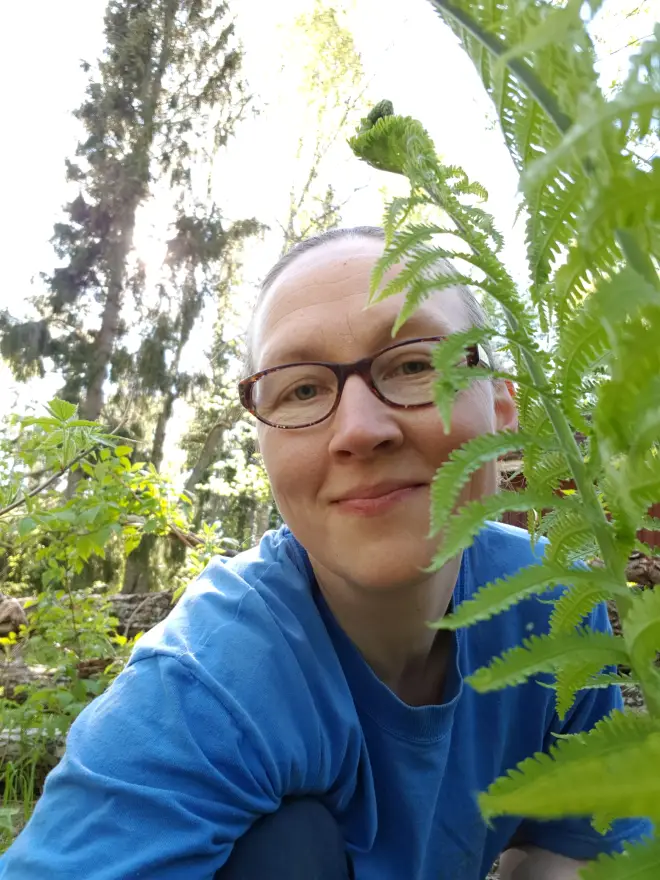Eco-Coordinator Works for Nature and Future Generations

Saara Korpela, who has worked on numerous sustainability projects in the visual arts, talks about sustainability work in the field, the carbon handprint and the possibility of art to question prevailing mindsets and create new aesthetics.
Saara Korpela has worked as an eco-coordinator in various arts organisations and, for example, coordinated the Vihreä art (Green Art) project, which aimed to integrate ecological sustainability into the daily operations of visual arts actors. In spring 2025, Korpela is involved in a project examining the ecological sustainability of public art in the city of Turku. As an eco-coordinator, Korpela has participated in planning, measuring, and communicating sustainability actions. She has also conducted sustainability training and drafted sustainability plans and ecological operating models for art productions.
Korpela often finds herself jumping onto a moving train: when she started at IHME Helsinki and the city of Turku, sustainability work was already well underway. The involvement of an eco-coordinator accelerates the process further. She is an expert who investigates relevant legislation, environmental certifications, and emission data – and considers how to apply them in the visual arts sector. The eco-coordinator offers more sustainable options to the organisation’s decision-makers.
I act as a person who thinks about the interests of the environment, nature, future generations, and other species, participates in meetings on their behalf, and takes a stand in decision-making, Korpela reflects.
Korpela has calculated carbon footprints, defined emission reduction targets, and studied the carbon handprint, which refers to the reduction of emissions in others’ activities, for example, due to the impact of an artwork.
You have to be as sharp as a tack with the handprint. In the art sector, there is a tendency to justify any activity by claiming it produces a handprint. However, it must be demonstrable.
According to Korpela, at its best, visual art can have the greatest impact precisely through its artistic content.
The Green Art Website Offers Sustainability Tools
Emissions in the visual arts sector have been declining, as in many other sectors. Despite promising developments, news about the massive increase in energy and water consumption due to the use of artificial intelligence worries many. Refusing existing technology can be a personal risk for an individual, Korpela reflects, but both artificial and organic intelligence should be used for the benefit of humanity. At times, it is difficult for her to act as an inspiring flag bearer, even though it is expected of an eco-coordinator, as every day brings shocking news of short-sighted and selfish actions.
Why invest in oil drilling and weapons when the money could be spent on sustainable infrastructure and cultural change?
But there is hope in working together. A good example of practical work towards a more sustainable future is the Green Art project, where Korpela served as project manager. Green Art brought together 14 visual arts organisations and produced concrete tools for visual arts actors to plan environmental work and calculate carbon footprints.
The project included a survey aimed at visual arts actors to identify the most useful measures and tools to support sustainability work. Based on the survey and workshop results, the Green Art website was created, featuring a calculator that provides a scale for large and small sustainability actions, for example, when planning exhibition productions.
The Kestävän kuvataiteen päivä (Sustainable Visual Art Day) organised within the framework of Green Art attracted a huge number of participants from a hundred different organisations in April 2024. The atmosphere was enthusiastic, and Korpela is pleased that ecological sustainability issues genuinely interest the visual arts field.
Thicket or Biodiversity Park?
The sustainability transition is also a change in social norms. Since a large part of people change their habits only when the change has become mainstream, Korpela considers it important that respected institutions like museums and libraries actively promote sustainability. This gives credibility to sustainability actions and increases understanding that it is not so-called green tinkering.
Additionally, Korpela calls for cooperation between different sectors and organisations. In Finland, each sector has created its own roadmap to carbon neutrality, but in addition to examining one’s own sector, cross-border cooperation is now needed. According to Korpela, it is motivating to see others also consider sustainability actions important and work towards them.
Recently, Korpela has paid attention to expectations and their shaping as part of societal change. When it comes to transitioning from one norm to another, the importance of communication cannot be overstated: it is crucial to proactively explain what is happening, when, and why. Sustainability communication is also a way for an organisation to show it is part of the change.
Communication can influence whether the audience sees a roadside thicket as a mess or as a biodiversity park important for pollinators and other rare species. A new aesthetic is currently being created, and visual art can help view things from a new perspective. Korpela hopes that in the future, the visual arts sector will continue to make visible the prevailing, outdated structures and thought patterns and create visions of change – together.